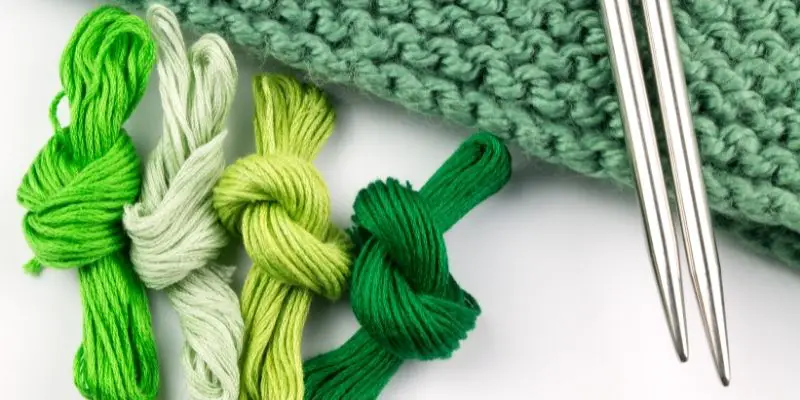Being a newbie yet enthusiastic crafter, you can come across a variety of sewing tools that would leave you just amazed considering the functions they perform. One of these tools is yarn darning needles.
But before diving into the details of a darning needle, let’s throw some light on what darning is.
Do you have a particular question about yarn darning needles? Then use the table of contents below to jump to the most relevant section. And you can always go back by clicking on the arrow in the right bottom corner of the page. Also, please note that some of the links in this article may be affiliate links. For more details, check the Disclosure section at the bottom of the page.
What is darning?
Darning is a method of fixing and repairing holes in clothing, particularly sweaters and socks. It not only extends the shelf life of your knitwear but also improves the quality of thin materials. It can be done by hand or machine, and it can also be apparent or invisible, depending on the style you choose. The whole process of darning is done using a special darning needle.
What is a Darning Needle?
A darning needle is unlike other sewing needles as it is comparatively big, and the tip isn’t much sharper like a regular needle. They come in various sizes and have an eye on the top, large enough for a darning thread (usually cotton or yarn) to pass through it.
When would you use Darning Needle?
Your sweater or socks may frequently become ripped and holed, causing the yarn to break and fray as it no longer follows the seam’s natural flow. That’s when a darning needle comes in handy as it fixes the holes in your knitwear (with the help of a darning yarn).
Since darning needles exist in various sizes, you can choose the one that best suits your needs. For instance, if you have a handmade sweater made of thick yarn, you’ll need a large darning needle. Likewise, you can use a smaller darning needle for thinner materials like store-bought socks.
In addition to that, darning needles are considered best if you’re allowing your kids to learn crafts. A darning needle’s blunt and dull tip makes sure they don’t prick their fingers while practicing, thus allowing them to learn faster without getting hurt.
Darning needle sizes
Darner needles range in size from 16 to 24 (in even numbers, i-e, 16,18, 20, 22, 24) and can be employed as needed. These needles are commonly used in knitting and crocheting tasks because their elongated eyes allow thick darning yarn to slip through effortlessly.
Large darning needles are suitable for larger projects, such as a hand-knitted sweater or a lap quilt. Similarly, the shorter needles are suited best for smaller projects, such as store-bought socks or lightweight, machine-made sweaters.
Speaking of which, size 16 or 18 would be suitable for machine-made knitwear. Whereas for handcrafted knitwear, a size 22 or 24 would be suitable.
Best projects to use darning needles
Darning needles can serve best when trying your hand on knitting and crocheting projects. However, the projects done with darning needles aren’t restricted to sweaters and socks only. You can do more fun and darning yarn wool projects using these needles.
These projects include darning sewing, which means sewing crocheted or knitted squares and motifs together to make blankets, cushions, and throws. You can also make yarn toys such as amigurumi. Besides embroidery, tapestry and counted cross stitch are also some of the best projects that can be accomplished using darn yarn needles and thread.
Best stitches to use with this needle
Darning needles can be used to make a variety of quick and straightforward stitches using darning yarn wool. The following are some examples of fundamental stitches:
Pattern Darning
Pattern Darning is a decorative embroidery technique that uses straight stitches in a parallel row to create a repeating or geometric design. Pattern darning is the easiest way to add design to your crafting project without having to master the art of complicated needlework techniques.
Net Darning
Net Darning is also called filet lace, embroidered net, or net embroidery. It is performed using darning, linen, or running stitch with a darning needle on a mesh ground or base to form a geometric design to imitate lace.
Needle Weaving
Needle Weaving is a decorative darning technique that combines embroidery and weaving. It’s done by weaving into the surface of the embroidery fabric. Needle weaving enables you to create vibrant artwork by filling in vast hand stitching and needlepoint spaces.
Tips for using a darning needle like a pro
To allow yourself to use a darning needle like a pro and make the most out of your darning experience, you need to keep a close check on a few points.
Since darning needles exist in various materials, lengths, tips, and variable-sized holes for the yarn to pass through. So, make sure that you’re using the correct needle size as the neatness of your project totally relies on it. Using a small needle for a thick yarn (and vice versa) won’t give you desirable results.
In addition to that, always ensure that you use a darning needle with a dull tip, as it will prevent the delicate fiber of wool from snagging and splitting.
Credits: photos by Canva

Disclosure: at sewingyourstyle.com we only write about the products that we’ve researched and considered worthy. But it’s important to mention that we are a participant of several affiliate programs, including Amazon Services LLC Associates Program, an affiliate advertising program designed to provide a mean for us to earn fees by linking to Amazon.com and affiliated sites. As an Amazon Associate sewingyourstyle.com earns from qualifying purchases.


